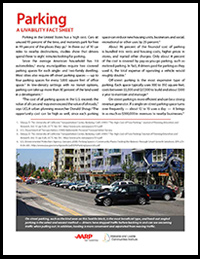AARP Hearing Center
The only time many of us think about the cost of parking a car is when we actually have to open our wallets and pay a fee, such as in a garage or at a parking meter.
But parking is expensive, whether we're paying for it directly or not. Consumers ultimately pay for parking through higher taxes and retail prices and reduced wages and benefits.
“The cost of all parking spaces in the U.S. exceeds the value of all cars and may even exceed the value of all roads,” says UCLA urban planning researcher Donald Shoup.
Key Points
Among the fact sheet's eye-opening points:
- In three out of 10 car rides to nearby destinations, drivers spend three to eight minutes looking for parking.
- About 96 percent of the financial cost of parking is bundled into rents and housing costs, higher prices in stores, and myriad other charges. If drivers paid for parking as they used it, the total expense of operating a vehicle would roughly double.
- In low-density settings with no transit options, parking can take up more than 50 percent of the land used in a development.
According to the authors, on-street parking is the most beneficial type of parking, and head-out angled parking is the safest and easiest method since drivers have stopped traffic before backing in and can see oncoming traffic when pulling out. (In addition, loading is more convenient and separated from moving traffic.)
Other recommendations include encouraging communities to adopt shared parking policies as opposed to the restricted parking practices that are now the norm. When parking areas allow shared use among different private and/or public sites that have peak parking demands at different times, fewer spaces are needed to meet the total peak parking demand in the vicinity. For instance, a church parking lot can be reserved for parishioners on Sundays or whenever the church is in heavy use, but opened as public parking at other times so drivers can access nearby stores and businesses.
One of the real life examples provided in the fact sheet is both inspiring and unexpected. In 1980, Berkeley, California, as well as the Massachusetts town of Arlington and city of Cambridge, began limiting their surface parking spaces. Research shows that the number of people and jobs climbed, as did incomes.
The reason: Less parking enabled the urban fabric to stitch back together with more room for shops, restaurants, jobs and other things that make cities great. The extra parking isn’t needed since people are driving less and living close to the urban core where nearly 30 percent walk or bike to work.
How to Use
Because the fact sheets in the Livability series are only four pages each, the materials are quick and easy to read online or to download and print for sharing.
The "Parking" fact sheet can be used by policy makers, transportation planners, community leaders and citizen activists to educate themselves and others and rethink how to best weave parking into the fabric of a community.
Fact sheet published Summer 2014





























































